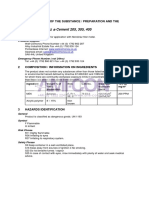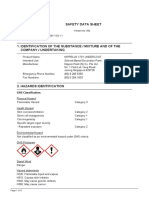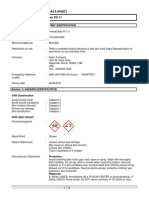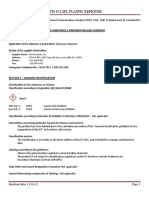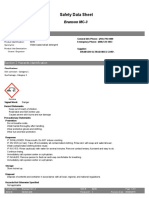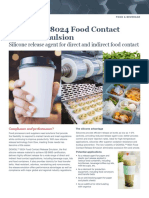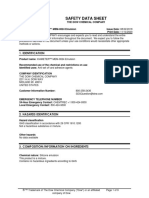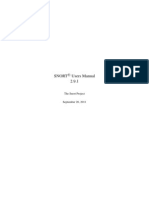Otis O12-CU Copper Remover GHS MSDS - REV 11-16-12
Otis O12-CU Copper Remover GHS MSDS - REV 11-16-12
Uploaded by
Laban KantorCopyright:
Available Formats
Otis O12-CU Copper Remover GHS MSDS - REV 11-16-12
Otis O12-CU Copper Remover GHS MSDS - REV 11-16-12
Uploaded by
Laban KantorOriginal Title
Copyright
Available Formats
Share this document
Did you find this document useful?
Is this content inappropriate?
Copyright:
Available Formats
Otis O12-CU Copper Remover GHS MSDS - REV 11-16-12
Otis O12-CU Copper Remover GHS MSDS - REV 11-16-12
Uploaded by
Laban KantorCopyright:
Available Formats
OTIS O12-CU COPPER REMOVER
May be used to comply with OSHA's Hazard Communication Standard 29CFR 1910. 1200. Standard must be consulted for
specific requirements.
SECTION 1 - IDENTIFICATION OF THE SUBSTANCE / PREPARATION AND COMPANY
Trade Name: Bore Tech Cu+2 Copper Remover
Application of the substance / preparation: Cleaning Compound
Details of the supplier Information:
Supplier Name: Otis Products, Inc
Address: PO Box 852, 6987 Laura Street; Lyons Falls, NY 13368
Phone: 315-348-4300
Fax: 315-348-4332
Emergency Telephone No.: CHEM-TREC 1-800-424-9300
SECTION 2 – HAZARDS IDENTIFICATION
Classification of the substance or mixture
Classification according to Regulation (EC) No1272/2008
GHS07
Skin Irrit. 2 H315 Causes skin irritation
STOT SE 3 H335-H336 May cause respiratory irritation. May cause drowsiness or dizziness.
Classification according to Directive 67/548/EEC or Directive 1999/45/EC
Xi; Irritant
R36/37/38
The full text for all risk phrases is displayed in Section 16
Information concerning particular hazards for human environment:
The product has to be labeled due to the calculation procedure of the “General Classification guideline for the
preparations of the EU” in the latest valid version.
Classification system:
The classification is according to the latest editions of the EU-lists, and extended by company and literature
data.
Labeling according to EU guidelines:
Observe the general safety regulations when handling chemicals
The product has been classified and marked in accordance with EU directives / Ordinance on Hazardous
Materials.
Revision date: 11.16.12 Page 1
OTIS O12-CU COPPER REMOVER
Code letter and hazard designation of product: Not applicable
Hazard-determining components of labeling: Not applicable
Risk phrases:
R36/37/38 Irritating to eyes/respiratory system/skin
Safety phrases:
1/2 Keep locked up and out of the reach of children
26 In case of contact with eyes, rinse immediately with plenty of water and seek medical advice
36/37/39 Wear suitable protective clothing, gloves and eye / face protection
45 in case of accident or if you feel unwell, seek medical advice immediately
SECTION 3 – COMPOSITION / INFORMATION ON INGREDIENTS
Dangerous Components
CAS: 205-483-3 Monoethanolamine C: 1B, H314; Xn; R20/21/22, H312, Acute 4-<25%
Tox. 4, H332, H227
CAS: 57-55-6 Propylene glycol Substance with a community workplace 3-10%
exposure limit; Acute Tox. 4, H302
Additional information: For the wording of the listed risk phrases refer to section 16
SECTION 4 – FIRST AID MEASURES
GENERAL INFORMATION
• Keep the affected person warm and at rest. Get prompt medical attention.
INHALATION
Move the exposed person to fresh air at once
Perform artificial respiration if breathing has stopped.
Keep the affected person warm and at rest.
Get prompt medical attention.
INGESTION
NEVER MAKE AN UNCONSCIOIUS PERSON VOMIT OR DRINK FLUIDS!
Drink plenty of water.
DO NOT induce vomiting. Get medical attention immediately.
SKIN CONTACT
Generally the product does not irritate the skin.
Remove affected person from source of contamination.
Promptly flush contaminated skin with water.
Promptly remove clothing if soaked through, flush the skin with water.
Get medical attention if any discomfort continues.
Revision date: 11.16.12 Page 2
OTIS O12-CU COPPER REMOVER
EYE CONTACT
Promptly wash eyes with plenty of water while lifting the eye lids.
Continue to rinse for at least 15 minutes and get medical attention.
Get medical attention immediately.
Continue to rinse.
MOST IMPORTANT SYMPTOMS AND EFFECTS, BOTH ACUTE AND DELAYED
Headache
Coughing
Allergic reactions
Blurred vision
SECTION 5- FIRE FIGHTING DATA
EXTINGUISHING MEDIA
Fire can be extinguished using: Water spray, fog or mist. Alcohol resistant foam. Carbon dioxide(CO2). Dry
chemicals, sand, dolomite etc.
SPECIAL FIRE FIGHTING PROCEDURES
Keep run-off water out of sewers and water sources. Dike for water control. Cool containers exposed to flames
with water until well after the fire is out. Move container from fire area if it can be done without risk. If risk of
water pollution occurs, notify appropriate authorities. Beware, risk of formation of toxic and corrosive gases.
UNUSUAL FIRE & EXPLOSION HAZARDS
Vapors are heavier than air and may spread near ground to sources of ignition.
SPECIFIC HAZARDS
Fire creates: Ammonia or amines. Oxides of: Nitrogen
SECTION 6 – ACCIDENTAL RELEASE MEASURE
PERSONAL PRECAUTIONS
Wear protective clothing as described in Section 8 of this safety data sheet.
ENVIRONMENTAL PRECAUTIONS
Prevent entry in drains. Avoid discharge onto the ground. Avoid release to the environment.
SPILL CLEAN UP METHODS
Stop leak if possible without risk. Ventilate well. Dilute with copious amount of water. Provide ventilation and
confine spill. Do not allow runoff to sewer. Collect and reclaim or dispose in sealed containers in licensed
waste. Avoid contact with skin or inhalation of spillage, dust or vapor. Clean-up personnel should use
respiratory and/or liquid contact protection.
See section 13 for disposal information.
Revision date: 11.16.12 Page 3
OTIS O12-CU COPPER REMOVER
SECTION 7 – HANDLING AND STORAGE
PRECAUTIONS FOR SAFE HANDLING
Store in cool, dry place in tightly closed receptacles
Keep receptacles tightly sealed
Keep away from heat, sparks and open flame
REQUIERMENTS FOR SAFE STORAGE, INCLUDING ANY INCOMPATIBILITIES
Store away from oxidizing agents
Store away from reducing agents
Unsuitable containers/metals: copper, zinc aluminum, alloy zinc, aluminum
FURTHER INFORMATION ABOUT STORAGE CONDITIONS
Protect from frost
Keep from freezing
Store under lock and key and out of the reach of children
Keep container tightly sealed
SECTION 8 – EXPOSURE CONTROLS / PERSONAL PROTECTION
Name Std LT-ppm LT-mg/m3 St - ppm ST – mg/m3
Monoethanolamine OES 3 ppm 7.6 mg/m3 6 ppm 15 mg/m3
INGREDIENT COMMENTS
OES = Occupational Exposure Standard.
PROTECTIVE EQUIPMENT
Protective Gloves: Use impermeable gloves.
Eye Protection: Wear safety/splash goggles.
Respiratory Protection: Not normally required.
If working in confined area or if excessive misting is expected an approved organic vapor mask should be worn.
Work/Hygienic Practices: Wash thoroughly after handling.
PROCESS CONDITONS
Use engineering controls to reduce air contamination to permissible exposure level.
Provide eyewash station.
ENGINEERING MEASURES
Provide adequate general and local exhaust ventilation
RESPIRATORY EQUIPMENT
If ventilation is insufficient, suitable respiratory protection must be provided.
Chemical respirator with organic vapor cartridge.
HAND PROTECTION
Use suitable protective gloves if risk of skin contact. Use protective gloves made of: Rubber, neoprene or PVC.
Revision date: 11.16.12 Page 4
OTIS O12-CU COPPER REMOVER
EYE PROTECTION
Wear approved, tight fitting safety glasses where splashing is probable.
OTHER PROTECTION
Wear appropriate clothing to prevent any possibility of liquid contact and repeated or prolonged vapor contact.
HYGIENE MEASURES
Do not smoke in work area.
Wash at the end of each work shift and before eating smoking and using the toilet.
Wash promptly if skin becomes wet or contaminated.
Promptly remove any clothing that becomes contaminated.
When using do not eat, drink or smoke.
SECTION 9 – PHYSICAL AND CHEMICAL PROPERTIES
APPEARANCE Liquid Clear
COLOUR Colorless Yellow
pH 10.5
ODOR Mild (or faint) pine
SOLUBILITY Completely soluble in water Soluble in Benzene Chloroform
BOLIING POINT(°C) ~ 105°C @ 760 mm Hg
MELTING POINT (°C) ~10
RELATIVE DENSITY 1.0
VAPOUR DENSITY N/D
VAPOUR PRESSURE N/D (air=1)
EVAPORATION RATE N/D
FLASH POINT (°c) > 110° C
SECTION 10 – STABILITY AND REACTIVITY
STABILITY
Stable under normal temperature conditions and recommended use.
CONDITIONS TO AVOID
Avoid heat, flames and other sources of ignition.
Avoid contact with acids and alkalies.
Avoid exposure to high temperatures.
SECTION 11 – TOXICOLOGICAL INFORMATION
TOXIC DOSE 1-ld 50:
2100 mg/kg (oral rat)
INHALATION
Prolonged inhalation of high concentrations may damage respiratory system.
Vapors may irritate respiratory system or lungs
Revision date: 11.16.12 Page 5
OTIS O12-CU COPPER REMOVER
INGESTION
Swallowing concentrated chemical may cause severe internal injury.
May cause chemical burns in mouth and throat.
May cause chemical burn in mouth, esophagus and stomach.
SKIN CONTACT
Strongly irritating.
Prolonged contact may cause burns.
EYE CONTACT
Extreme irritation of eyes and mucous membranes, including burning.
Risk of damage to eyes.
HEALTH WARNINGS
Gas or vapors may be irritating even on brief exposure.
This chemical may cause skin/eye irritation and burns (corrosive).
Repeated exposure may cause chronic eye irritation.
Swallowing concentrated chemical may cause severe internal injury.
ROUTE OF ENTRY
Inhalation/ Ingestion/ Skin and/or Eye Contact
TARGET ORGANS
Eyes, Kidneys, Liver, Respiratory System, Lungs, Skin.
MEDICAL SYMPTOMS
Extreme irritation of eyes and mucous membranes, including burning.
Pharyngitis (inflammation of back of mouth).
General respiratory distress, unproductive cough.
Severe skin irritation.
MEDICAL CONSIDERATIONS
Skin disorders and allergies.
Splash in eye requires examination by eye specialist.
SECTION 12 – ECOLOGICAL INFORMATION
LC 50, 96 Hrs, FISH mg/l 150 Rainbow Trout
EC 50, 48 Hrs, DAPHNIA, mg/l 33
MOBILITY
Dissolves in water
BIOACCUMULATION
Does not bioaccumulate significantly
DEGRADABILITY
Readily biodegradable
Revision date: 11.16.12 Page 6
OTIS O12-CU COPPER REMOVER
SECTION 13 – DISPOSAL CONSIDERATIONS
GENERAL INFORMATION
Contaminated packages must be completely emptied before sending away for laundering and re-use.
DISPOSAL METHODS
Dispose of waste and residues in accordance with local authority requirements.
Confirm disposal procedures with environmental engineer and local regulations.
SECTION 14 – TRANSPORT INFORMATION
DOT Shipping Information
This product is considered to be a non- hazardous material and not regulated by the D.O.T.
ADR, IMDG, IATA Shipping Information
This material is considered non-hazardous
ADR, IMDG, IATA Not applicable
UN PROPER SHIPPING NAME
ADR, IMDG, IATA Not applicable
Transport Hazard Class(es)
ADR, IMDG, IATA Not applicable
Class
Label Not applicable
Packing group
ADR, IMDG, IATA Not applicable
Environmental Hazards:
Marine pollutant No
Special precautions for users
Dander Code (Kemler): Not applicable
EMS Number
Segregation groups: Not applicable
Transport in bulk according to Annex II of
MARPOL73/78 and the IBC Code
Transport/ Additional information Not applicable
ADR
Limited quantities (LQ)
Transport category
Revision date: 11.16.12 Page 7
OTIS O12-CU COPPER REMOVER
Tunnel restriction code Not applicable
UN “Model Regulation”: Not applicable
SECTION 15 – REGULATORY INFORMATION
LABELING non-hazardous mixture
CONTAINS Monoethanolamine
SECTION 16 – OTHER INFORMATION
This information is based on our present knowledge. However, this shall not constitute a guarantee for any
specific product features and shall not establish a legally valid contractual relationship.
Relevant phrases
H302 Harmful if swallowed
H312 Harmful in contact with skin
H332 Harmful if inhaled
R20/21/22 Harmful by inhalation, in contact with the skin and if swallowed
R36/37/38 Irritating to eyes/respiratory system/skin
S45 In case of accident or if you feel unwell, seek medical advice immediately
S51 Use only in well-ventilated areas.
S24/25 Avoid contact with skin and eyes.
S36/37/39 Wear suitable protective clothing, gloves and eye/face protection.
UK REGULATORY REFERENCES
Health and Safety at Work Act 1974.
The Control of Substances Hazardous to Health Regulations 1988.
Chemicals (Hazard Information & Packaging) Regulations.
ENVIRONMENTAL LISTING
Environmental Protection Act 1990 Special Waste Regulations 1996
EU DIRECTIVES
Dangerous Substance Directive 67/548/EEC.
Dangerous Preparations Directive 1994/45/EEC.
APPROVED CODE OF PRACTIVE
Safety Data Sheets for Substances and Preparations.
Classification and Labeling of Substances and Preparations Dangerous for Supply.
GUIDANCE NOTES
Occupational Exposure Limits EH40.
Revision date: 11.16.12 Page 8
OTIS O12-CU COPPER REMOVER
REVISION DATE 11/16/12
REV. NO./REPL. SDS GENERATED ISSUE NO2
SAFETY DATA SHEET STATUS Approved
DISCLAIMER
This information relates only to the specific material designated and may not be valid for such material used in
combination with any other materials or in any process. Such information is, to the best of the company’s knowledge
and belief, accurate and reliable as of the date indicated. However, no warranty guarantee or representation is made to
its accuracy, reliability or completeness. It is the user’s responsibility to satisfy themselves as to the suitability of such
information for their own particular use.
Revision date: 11.16.12 Page 9
You might also like
- Cito Mock Exam Ipma Level D Open Questions AnswersDocument7 pagesCito Mock Exam Ipma Level D Open Questions Answerszagorje1230% (1)
- ESD - QuizizzDocument17 pagesESD - QuizizzHoda FakourNo ratings yet
- Weld-On 3 MsdsDocument2 pagesWeld-On 3 MsdsSergio SanchezNo ratings yet
- Circular - MCGM For Fungible FSIDocument4 pagesCircular - MCGM For Fungible FSIMehul ZaveriNo ratings yet
- Monolix-4 3 3-UsersGuideDocument183 pagesMonolix-4 3 3-UsersGuidedionnotaryNo ratings yet
- Otis Carbon Remover-C MSDSDocument9 pagesOtis Carbon Remover-C MSDSFebrianto DimazNo ratings yet
- Wall Colmonoy Nicrobraz 205 305 405 Cement MSDSDocument5 pagesWall Colmonoy Nicrobraz 205 305 405 Cement MSDSJ. BangjakNo ratings yet
- All Purpose Thinner Sep11Document4 pagesAll Purpose Thinner Sep11Paul De ChaufepieNo ratings yet
- Msds ResinDocument5 pagesMsds ResinJenyNo ratings yet
- MSDS TBBS Nouvel AccélérantDocument6 pagesMSDS TBBS Nouvel AccélérantJean GrégoireNo ratings yet
- Identification of The Substance / Mixture and of The Company / UndertakingDocument9 pagesIdentification of The Substance / Mixture and of The Company / UndertakingAriful Mas'udNo ratings yet
- EnSolv NEXT SDSDocument4 pagesEnSolv NEXT SDSyetty dharmayantiNo ratings yet
- Mono Ethylene Glycol MEGDocument6 pagesMono Ethylene Glycol MEGtabriz.alizada.engNo ratings yet
- MSDS Sodium Hypochlorite SolutionDocument5 pagesMSDS Sodium Hypochlorite SolutionAhmed GhariebNo ratings yet
- MSDS Demulsifier 334 (CL-344-L 2017) Rev 1Document5 pagesMSDS Demulsifier 334 (CL-344-L 2017) Rev 1dwi ari wNo ratings yet
- Premalube Red MsdsDocument3 pagesPremalube Red Msdsfreddy william montalban palaciosNo ratings yet
- MSDS Sodium NitriteDocument5 pagesMSDS Sodium NitritemarcNo ratings yet
- Identification of The Substance / Mixture and of The Company / UndertakingDocument8 pagesIdentification of The Substance / Mixture and of The Company / UndertakingzuhandriNo ratings yet
- SDS - 1,2 BENZISOTHIAZOLINE-3-ONEDocument5 pagesSDS - 1,2 BENZISOTHIAZOLINE-3-ONEAlexandre MedeirosNo ratings yet
- MSDS HCLDocument8 pagesMSDS HCLdaniNo ratings yet
- MSDS Aceite Esencial de NaranjaDocument4 pagesMSDS Aceite Esencial de NaranjaCosmetica BrillantNo ratings yet
- Alkaline Membrane CleanerDocument4 pagesAlkaline Membrane CleanerIbrahimNo ratings yet
- MSDS (16) Foamaxx QS PlusDocument4 pagesMSDS (16) Foamaxx QS PlusKhadar SetiawanNo ratings yet
- Molybdate - Reagent For SilicaDocument8 pagesMolybdate - Reagent For SilicaHari KrishnanNo ratings yet
- Material Safety Data Sheet Zinc Sulphate Monohydrate: Section 1: Product and Producer/Supplier DetailsDocument4 pagesMaterial Safety Data Sheet Zinc Sulphate Monohydrate: Section 1: Product and Producer/Supplier DetailsMartha SuarezNo ratings yet
- Pipe Grip Type N Conduit CementDocument5 pagesPipe Grip Type N Conduit Cementadriansahagun209No ratings yet
- 1712 Alkafoam FDocument6 pages1712 Alkafoam FfatihabiyayNo ratings yet
- Alumunium Chlorohydrate: Material Safety Data SheetDocument4 pagesAlumunium Chlorohydrate: Material Safety Data Sheethinur awaNo ratings yet
- MSDS PengentalDocument3 pagesMSDS Pengentaltaufik akfaNo ratings yet
- 845.1600 Truplug HT Retarder (MSDS)Document3 pages845.1600 Truplug HT Retarder (MSDS)U.s. Ezhil ArivudainambiNo ratings yet
- Product and Supplier Identification: Dr. Alex Rusinoff, President & ChairmanDocument5 pagesProduct and Supplier Identification: Dr. Alex Rusinoff, President & ChairmanKerron RekhaNo ratings yet
- Material Safety Data Sheet: #360F Liquid Flux 1. Product and Company IdentificationDocument5 pagesMaterial Safety Data Sheet: #360F Liquid Flux 1. Product and Company IdentificationteknoartistNo ratings yet
- Safety Data Sheet: SDS 094 Page 1 of 1Document4 pagesSafety Data Sheet: SDS 094 Page 1 of 1Gerai AchazaNo ratings yet
- DCP MSDSDocument9 pagesDCP MSDSOnesany TecnologiasNo ratings yet
- 1187 SdsDocument12 pages1187 Sdsanthony tiensunNo ratings yet
- DSMS Hand Sanitizer PDFDocument9 pagesDSMS Hand Sanitizer PDFDR PRO CLEAN OFFICIAL HQNo ratings yet
- Section 1 Product and Company Information: Propionic AcidDocument4 pagesSection 1 Product and Company Information: Propionic AcidBeatrix DhoneNo ratings yet
- Safety Data Sheet: Section 2: Hazards IdentificationDocument5 pagesSafety Data Sheet: Section 2: Hazards IdentificationaldiNo ratings yet
- Grease Bearing SKFDocument6 pagesGrease Bearing SKFNNNo ratings yet
- Proton Guardian SDSDocument2 pagesProton Guardian SDSwrichardsNo ratings yet
- 530 GHS Laundry Powder EconomyDocument6 pages530 GHS Laundry Powder EconomyRaymond TuazonNo ratings yet
- Safety Data Sheet: Metalcrete IndustriesDocument4 pagesSafety Data Sheet: Metalcrete IndustriesCarlos Alberto Luyo BuendíaNo ratings yet
- MSDS Kaigo Fuel Injection CleanerDocument6 pagesMSDS Kaigo Fuel Injection CleanerJhonAceMalauNo ratings yet
- Nippon 20 14 Epoxy U Coat SDSDocument17 pagesNippon 20 14 Epoxy U Coat SDSahmad sirojuddinNo ratings yet
- 126 Sodium HypochloriteDocument6 pages126 Sodium HypochloriteElmer MissiorNo ratings yet
- HYCLOR Liquid Chlorine 12.5L&5L - SDSDocument6 pagesHYCLOR Liquid Chlorine 12.5L&5L - SDSFarhad JabNo ratings yet
- Otis O12-PL Plastic Remover GHS MSDS - REV 11-16-12Document8 pagesOtis O12-PL Plastic Remover GHS MSDS - REV 11-16-12Laban KantorNo ratings yet
- SDS - Nippon Paint HI-PON-50-01-POLYURETHANE-TOP-COATDocument8 pagesSDS - Nippon Paint HI-PON-50-01-POLYURETHANE-TOP-COATIvan NguyenNo ratings yet
- 10% NaOCl MSDS PDFDocument6 pages10% NaOCl MSDS PDFHimat KhimaniNo ratings yet
- MSDS Colour - Sunset Yellow - KrisDocument3 pagesMSDS Colour - Sunset Yellow - KrisHernanValenciaNo ratings yet
- Caustic Soda Flakes MsdsDocument3 pagesCaustic Soda Flakes MsdsVimal SevakNo ratings yet
- Safety Data Sheet M-I Cide: 1. Identification of The Substance/Preparation and Company/UndertakingDocument5 pagesSafety Data Sheet M-I Cide: 1. Identification of The Substance/Preparation and Company/UndertakingJose AlejandroBlancoNo ratings yet
- Lambda 10 EC MSDSDocument5 pagesLambda 10 EC MSDSأبو أميرNo ratings yet
- 302 1006 003 Make Up750ml MEK United StatesDocument8 pages302 1006 003 Make Up750ml MEK United StatesLeonor Virginia GalindezNo ratings yet
- Ptei Estocure P - Sds - 190405Document5 pagesPtei Estocure P - Sds - 190405Denis nataliaNo ratings yet
- 1107 Sani Hands SdsDocument6 pages1107 Sani Hands SdsMehmethan TutukNo ratings yet
- 846.1500 Trupol Plug Accelerator (MSDS)Document4 pages846.1500 Trupol Plug Accelerator (MSDS)U.s. Ezhil ArivudainambiNo ratings yet
- Mobil Eal Arctic 068Document7 pagesMobil Eal Arctic 068José Azael Suárez RamírezNo ratings yet
- Nippon 9000 - SDSDocument8 pagesNippon 9000 - SDSNg MaxNo ratings yet
- Material Safety Data Sheet: Section 1 - Chemical Product and Company IdentificationDocument7 pagesMaterial Safety Data Sheet: Section 1 - Chemical Product and Company IdentificationTeresa SilvaNo ratings yet
- Material Safety Data Sheet: Section 1: Product and Company IdentificationDocument4 pagesMaterial Safety Data Sheet: Section 1: Product and Company IdentificationIka KusumawatiNo ratings yet
- MSDS Os1lDocument4 pagesMSDS Os1lJose AlejandroBlancoNo ratings yet
- After a Disaster - Information to Help You and Your Family RecoverFrom EverandAfter a Disaster - Information to Help You and Your Family RecoverNo ratings yet
- US5888954 Benzotriazole As Silver Corrosion Inhibitor in Dishwashing DetergentsDocument7 pagesUS5888954 Benzotriazole As Silver Corrosion Inhibitor in Dishwashing DetergentsLaban KantorNo ratings yet
- Quick SpecsDocument44 pagesQuick SpecsLaban KantorNo ratings yet
- Corrosion Inhibition of Steel in Phosphoric Acid Khadom2018Document14 pagesCorrosion Inhibition of Steel in Phosphoric Acid Khadom2018Laban KantorNo ratings yet
- Wipe-Out Brushless Bore Cleaner All InfoDocument19 pagesWipe-Out Brushless Bore Cleaner All InfoLaban KantorNo ratings yet
- MSDS Sweets 762Document5 pagesMSDS Sweets 762Laban KantorNo ratings yet
- Otis O12-PL Plastic Remover GHS MSDS - REV 11-16-12Document8 pagesOtis O12-PL Plastic Remover GHS MSDS - REV 11-16-12Laban KantorNo ratings yet
- Hoppes No. 9 Gun Bore CleanerDocument20 pagesHoppes No. 9 Gun Bore CleanerLaban KantorNo ratings yet
- Safety Data Sheet: SECTION 1: Identification of The Substance/mixture and SupplierDocument10 pagesSafety Data Sheet: SECTION 1: Identification of The Substance/mixture and SupplierLaban KantorNo ratings yet
- Safety Data Sheet: Section 1 Identification of The Substance / Preparation and CompanyDocument8 pagesSafety Data Sheet: Section 1 Identification of The Substance / Preparation and CompanyLaban KantorNo ratings yet
- Product and Company Identification: Goof Off Professional Strength VOC Compliant Safety Data SheetDocument9 pagesProduct and Company Identification: Goof Off Professional Strength VOC Compliant Safety Data SheetLaban KantorNo ratings yet
- Hoppe's No. 9 Black Powder Gun Bore CleanerDocument16 pagesHoppe's No. 9 Black Powder Gun Bore CleanerLaban KantorNo ratings yet
- Ultrasonic Cleaning Solution, MC-3 - Metal Cleaner - SdsDocument5 pagesUltrasonic Cleaning Solution, MC-3 - Metal Cleaner - SdsLaban KantorNo ratings yet
- Ultrasonic Cleaning Solution, JC - Jewelry Cleaner - SdsDocument6 pagesUltrasonic Cleaning Solution, JC - Jewelry Cleaner - SdsLaban KantorNo ratings yet
- Rust Cleaner Rust Breaker Heavy Duty SdsDocument13 pagesRust Cleaner Rust Breaker Heavy Duty SdsLaban KantorNo ratings yet
- DOWSIL™ 2-9034 Emulsion: Features & BenefitsDocument5 pagesDOWSIL™ 2-9034 Emulsion: Features & BenefitsLaban KantorNo ratings yet
- DOWSIL™ 8024 Food Contact Release Emulsion - BrochureDocument2 pagesDOWSIL™ 8024 Food Contact Release Emulsion - BrochureLaban KantorNo ratings yet
- Construction 63 1053 Dowsil Ie 6694 Water RepellentDocument2 pagesConstruction 63 1053 Dowsil Ie 6694 Water RepellentLaban KantorNo ratings yet
- Polyquart Ampho 149: Technical InformationDocument3 pagesPolyquart Ampho 149: Technical InformationLaban Kantor100% (1)
- DOWSIL™ IE 6694 Water Repellent New Emulsion: by Jennifer Middleton and Dave SelleyDocument15 pagesDOWSIL™ IE 6694 Water Repellent New Emulsion: by Jennifer Middleton and Dave SelleyLaban KantorNo ratings yet
- XIAMETER™ PMX-200 Silicone Fluid, 1000 CST, Food Grade-TDSDocument4 pagesXIAMETER™ PMX-200 Silicone Fluid, 1000 CST, Food Grade-TDSLaban KantorNo ratings yet
- XIAMETER™ MEM-0024 Emulsion: Features & BenefitsDocument2 pagesXIAMETER™ MEM-0024 Emulsion: Features & BenefitsLaban KantorNo ratings yet
- Safety Data Sheet: 1. IdentificationDocument9 pagesSafety Data Sheet: 1. IdentificationLaban KantorNo ratings yet
- BASF Industrial & Institutional Cleaning Automatic Dish WashingDocument11 pagesBASF Industrial & Institutional Cleaning Automatic Dish WashingLaban KantorNo ratings yet
- Hoppes Elite Foaming Gun Cleaner PDFDocument12 pagesHoppes Elite Foaming Gun Cleaner PDFLaban KantorNo ratings yet
- Basf Home Care and I&i 2020 Guide To Sustainable IngredientsDocument20 pagesBasf Home Care and I&i 2020 Guide To Sustainable IngredientsLaban Kantor100% (1)
- JSA-005 General Lifting Activity by Crane or Boom-TruckDocument5 pagesJSA-005 General Lifting Activity by Crane or Boom-Truckqadeer55afridiNo ratings yet
- Marketing Mix of Motorola Co. Ltd.Document66 pagesMarketing Mix of Motorola Co. Ltd.asus laptopNo ratings yet
- Health Education of Menstrual Hygiene 1Document12 pagesHealth Education of Menstrual Hygiene 1chaudharitrushar007100% (1)
- Types of Scientific ResearchDocument3 pagesTypes of Scientific ResearchGul JeeNo ratings yet
- +GF+Butterfly Valves Type 567 and 578Document12 pages+GF+Butterfly Valves Type 567 and 578ROMNANo ratings yet
- Gas Turbine EngDocument23 pagesGas Turbine EngFatur RachmanNo ratings yet
- Netsanet Abebe Final Research NewDocument61 pagesNetsanet Abebe Final Research Newbeletemelaku391No ratings yet
- FTP HackingDocument2 pagesFTP HackingAbhishek KunalNo ratings yet
- Lecture #19: Moments of InertiaDocument19 pagesLecture #19: Moments of InertiaAfiqah ZainuddinNo ratings yet
- Answer KeyDocument2 pagesAnswer KeyJeremy PanerioNo ratings yet
- Snort ManualDocument220 pagesSnort Manualfububoy87No ratings yet
- Power Star AVR Selection GuideDocument1 pagePower Star AVR Selection GuideAnqhas MisiNo ratings yet
- Gender Inequality in Extreme Metal MusicDocument17 pagesGender Inequality in Extreme Metal MusicNícolas AqsenenNo ratings yet
- Kushal Bhatia CRAP Elections 2015 Task2Document7 pagesKushal Bhatia CRAP Elections 2015 Task2kushalNo ratings yet
- Round 1 Written TestDocument24 pagesRound 1 Written Testapi-344837074No ratings yet
- E-Thor Energy LimitedDocument12 pagesE-Thor Energy LimitedSuhasi ThakarNo ratings yet
- User GuideDocument74 pagesUser GuideJohnny AlfaNo ratings yet
- British and American TermsDocument14 pagesBritish and American TermsL Anabella Mendoza DvNo ratings yet
- Ceguera Technological Colleges: Service-Based Home Business Ideas IncludeDocument4 pagesCeguera Technological Colleges: Service-Based Home Business Ideas IncludeGienelle BermidoNo ratings yet
- Non Performing AssetsDocument53 pagesNon Performing AssetsAbhishek BhoopalamNo ratings yet
- Gen Physics 1 Test q4 Version 2-FreeDocument51 pagesGen Physics 1 Test q4 Version 2-FreeJoel PalopeNo ratings yet
- Big, Bold, Classic Light, Crisp, Refreshing Beer: Cranpa JackDocument2 pagesBig, Bold, Classic Light, Crisp, Refreshing Beer: Cranpa JackTierney PlumbNo ratings yet
- Appendix 04: Critical Values For T-Test: ContributorsDocument1 pageAppendix 04: Critical Values For T-Test: ContributorsGraviton Manzano OlarteNo ratings yet
- Chapter 14Document38 pagesChapter 14Screw Soft (Screw Soft Channel)No ratings yet
- GOTIE Karta - GBE-200Z - enDocument1 pageGOTIE Karta - GBE-200Z - enbeizanisNo ratings yet
- K-501-T, SPV SWTDocument1 pageK-501-T, SPV SWTamir shokrNo ratings yet






